The Kite is a large northern asterism that dominates the constellation Boötes. Also known as the Ice Cream Cone, it is formed by the constellation’s brightest stars. Like the Big Dipper in Ursa Major, the Kite gives Boötes its alternative name: the Kite constellation.
The Kite is one of the most prominent spring asterisms in the northern hemisphere, along with the Big and Little Dippers, the Diamond of Virgo, and the Spring Triangle. Easily spotted between the Big Dipper and Corona Borealis on a clear night, the Kite is slightly less conspicuous than these two but no less interesting. It contains Arcturus, the brightest northern star, Izar, one of the best-known double stars in the sky, and Tau Boötis, a main sequence star that was propelled into the spotlight in 2020 as the host star of the first extrasolar planet from which radio emission may have been detected.
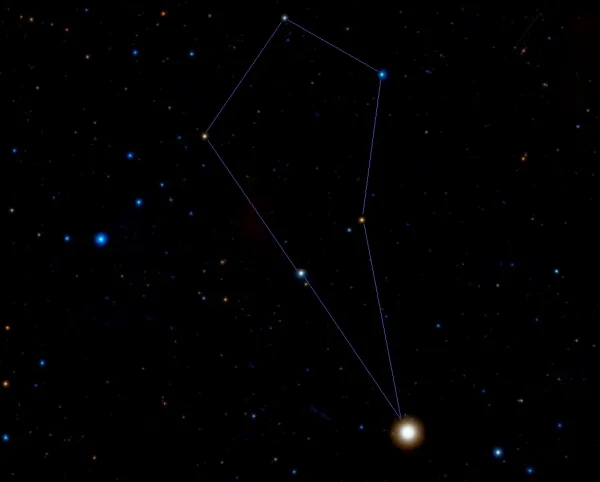
The Kite in the constellation Boötes, image: Wikisky
Stars
The six main stars that form the Kite are Arcturus (Alpha Boötis), Izar (Epsilon Boötis), Princeps (Delta Boötis), Nekkar (Beta Boötis), Seginus (Gamma Boötis), and Rho Boötis. Some consider the asterism to be formed of only four stars – Arcturus, Princeps, Nekkar and Seginus – while others give the Kite a tail (Eta, Tau and Upsilon Boötis) and tether (Zeta Boötis). Unlike constellations, which have clear boundaries, asterisms are not formally defined by the IAU, which is why there are several different versions of the Kite.
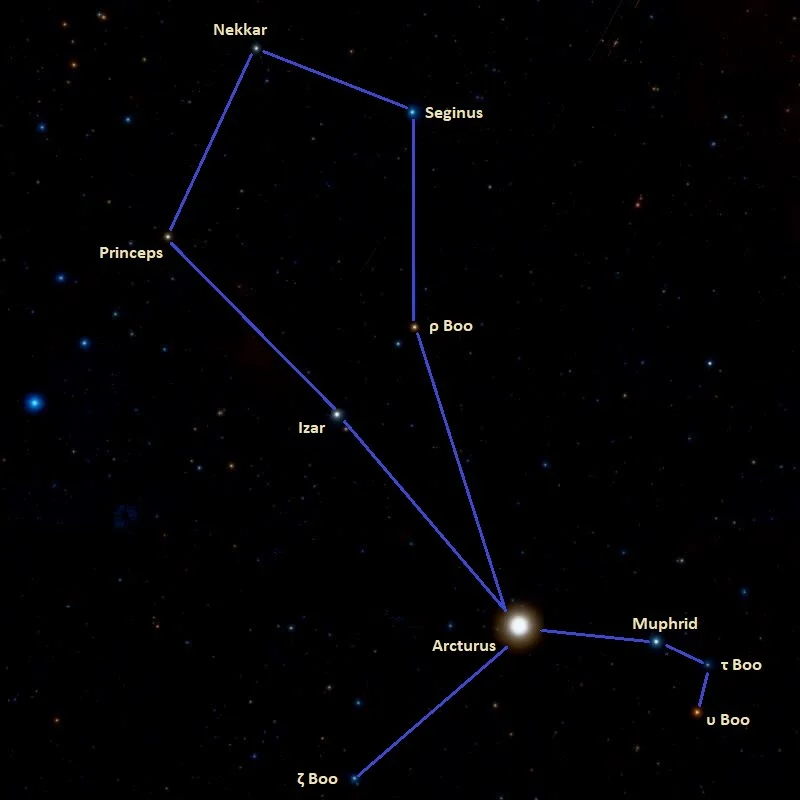
Kite stars, image: Wikisky
The Kite is formed mostly of giant and subgiant stars. The brightest of these is the constellation’s luminary Arcturus, the brightest star in the northern celestial hemisphere and fourth brightest star in the sky. Arcturus is one of our nearest bright neighbours, located only 36.7 light years away. With an apparent magnitude of -0.05, it is only fainter than Sirius, Canopus, and Alpha Centauri. The latter two are invisible from mid-northern latitudes, which makes Arcturus the second brightest star seen from most of Europe and North America.
Arcturus is a red giant with the stellar classification K0 III. It has about the same mass as the Sun (1.08 solar masses) and is older than our star, with an estimated age of 7.1 billion years. As it evolved away from the main sequence, Arcturus has expanded to a size of 25.4 solar radii. With a surface temperature of 4,286 K, it is 170 times more luminous than the Sun.
Arcturus is part of two other prominent asterisms. It forms the Spring Triangle with Denebola (or alternatively Regulus) in Leo and Spica in Virgo, and the Great Diamond with Spica, Denebola and Cor Caroli, the brightest star in the constellation Canes Venatici.
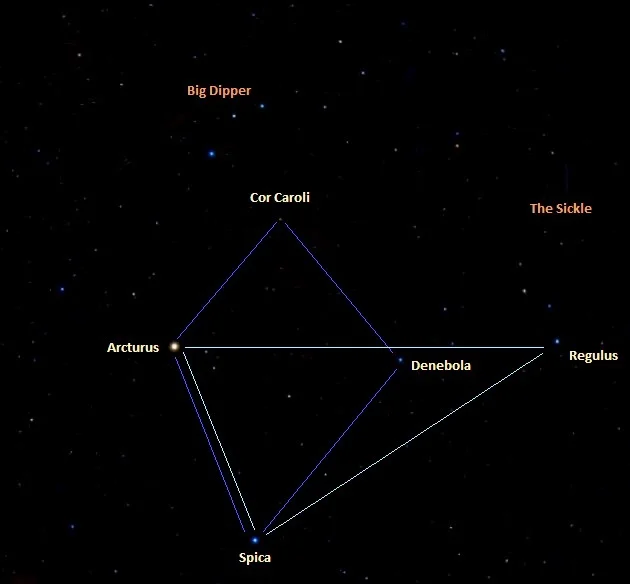
The Spring Triangle and the Great Diamond of Virgo, image: Wikisky
The name Arcturus comes from the Greek Ἀρκτοῦρος, meaning “guardian of the bear.” The bear in question is Ursa Major.
Izar, Epsilon Boötis, is the second brightest star in Boötes, with an apparent magnitude of 2.37. Izar is the primary component in a binary system located about 203 light years away. The system is a popular target for small telescopes.
The brighter component is an evolved orange giant or bright giant of the spectral type K0 II-III with a mass 4.6 times that of the Sun and a radius 33 times solar. With a surface temperature of 4,500 K, it shines with 501 solar luminosities. Even though it appears similar to Arcturus, Izar is much younger, with an estimated age of only 37.4 million years. While Arcturus follows its evolutionary path at a more leisurely pace, Izar has evolved faster due to its high mass and will therefore have a shorter life. It is not, however, massive enough to go out as a supernova and will instead meet its end as a faint white dwarf.
The star’s traditional name, Izar, comes from the Arabic word for “veil.”
Izar’s companion is a white main sequence star with the stellar classification A2 V. It has a visual magnitude of 5.12. The two stars are separated by 2.852 ± 0.014 arcseconds, which corresponds to a physical separation of 185 light years. The stars take at least a thousand years to complete an orbit.
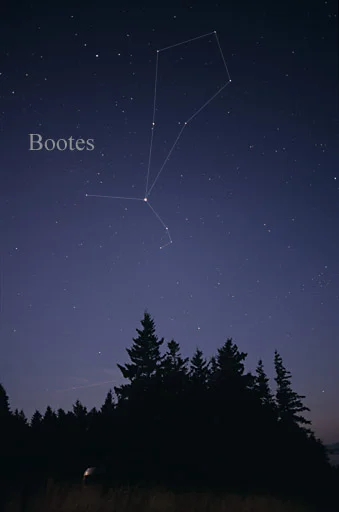
The Kite in Boötes, image: Till Credner (CC BY-SA 3.0)
Delta Boötis, traditionally (but not formally) known as Princeps, is another binary system. It consists of a pair of yellow-white stars, one a giant (G8 III) and the other still on the main sequence (G0 V). The brighter component, the giant, has an apparent magnitude of 3.482, while the dwarf is considerably fainter and invisible to the unaided eye at magnitude of 7.81.
The primary component has a radius 10.5 times that of the Sun and is 53.7 times more luminous than our star.
Nekkar, Beta Boötis, is another yellow giant. It has the stellar classification G8IIIa. It marks the head of the celestial Herdsman. The star shines at magnitude 3.488 from a distance of 225 light years. It is twice the size of Delta Boötis, with a radius 21.5 times that of the Sun. It has a mass of 3.4 solar masses and is between 170 and 194 times more luminous than the Sun. Its estimated age is between 240 and 251 million years.
Nekkar is classified as a flare star. An X-ray flare was detected on the star in 1993. This was the first such detection on a star in its class and may be explained by an unseen red dwarf companion. (Most flare stars are red dwarfs.)
The name Nekkar comes from the Arabic name for the constellation Boötes, Al Baḳḳār (the Herdsman).
Seginus is the brighter of the two components of the Gamma Boötis system. It has an apparent magnitude of 3.03 and lies 86.8 light years away. It marks the Herdsman’s shoulder.
Seginus is a white bright giant star of the spectral type A7 IV+(n). It has a mass of 2.10 solar masses and a radius about 5.16 times that of the Sun. It shines with 33.4 solar luminosities with an effective temperature of 7,800 K. The star is a fast spinner, with a projected rotational velocity of 121 km/s. It is believed to be between 0.9 and 1 billion years old.
Seginus is classified as a Delta Scuti variable, a variable star whose brightness fluctuates due to pulsations. The star’s brightness varies from magnitude 3.02 to 3.07 over a period of 6.96753 hours.
The name Seginus is derived from cheguius or theguius, both Latin mistranscriptions of the Arabic transliteration of the Greek name for the constellation Boötes.
Rho Boötis is a class K star on the red giant branch, like Arcturus. It has the stellar classification K4 III and shines at magnitude 3.59 from a distance of 160 light years. It is older than Arcturus, with an estimated age of 10.11 billion years.
The star has a mass between 1.0 and 1.4 solar masses and a radius 21.57 times that of the Sun. It is 131.9 times more luminous than the Sun with a surface temperature of 4,298 K.
Muphrid is the brighter of the two components of the Eta Boötis system. With an apparent magnitude of 2.680, it is the third brightest star in Boötes, after Arcturus and Izar. Like Arcturus, it is one of our nearest bright neighbours, located at a distance of 37.2 light years.
Muphrid does not only appear close to Arcturus in the sky but is physically close to the giant. Arcturus is its nearest neighbour. The two stars are separated by only 3.24 light years, which is less than the distance from the Sun to Proxima Centauri (4.2465 ly). To an observer in the Arcturus system, Muphrid would appear as a magnitude -2.5 star (comparable to the brightness of Mercury), while Arcturus would appear as bright as Venus when seen from the Eta Boötis system.
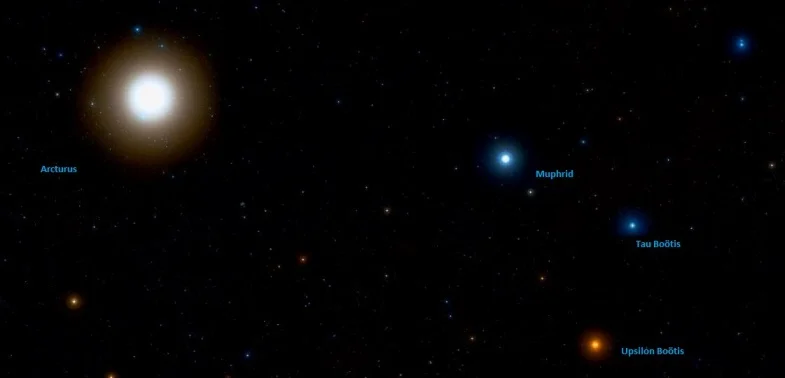
Arcturus, Muphrid, Tau and Upsilon Boötis, image: Wikisky
Muphrid has the spectrum of a yellow subgiant of the spectral type G0 IV. It has a mass of 1.71 solar masses and a radius 2.672 times that of the Sun. It shines with 8.89 solar luminosities with an effective temperature of 6,100 K. The star’s estimated age is 2.7 billion years.
The name Muphrid comes from the Arabic mufrid ar-rāmiħ, meaning “the one of the lancer.”
Tau Boötis is another binary system. It is composed of a white main sequence star or subgiant with the stellar classification F7IV-V and a red dwarf of the spectral type M3V. The system lies 50.9 light years away.
The primary component, Tau Boötis A, has a mass of 1.39 solar masses and a radius 1.42 times that of the Sun. With a surface temperature of 6,399 K, it is 3.06 times more luminous than our star. It is much younger than the Sun, with an estimated age between 1.6 and 2.3 billion years.
The companion, Tau Boötis B, has about half the Sun’s mass and radius. It orbits Tau Boötis A at a distance of 220 astronomical units.
A planet, a hot Jupiter, was announced to be orbiting Tau Boötis A in 1996. It was one of the first exoplanets to be discovered. Designated Tau Boötis b, the planet has about 6 Jupiter masses and orbits the host star with a period of 3.312463 days. The planet orbits in a “torch orbit,” at a distance of only 0.0481 astronomical units, which is less than a seventh of the distance between Mercury and the Sun.
A 1997 study suggested that the star and the planet were tidally locked (i.e. that they always show the same face to each other) since the star rotates with a period that corresponds to the planet’s orbital period.
In 2020, an international team of scientists announced the detection of radio bursts from the Tau Boötis system. The team suggested that, if the signal was real, it probably came from the planetary system. This would be the first time that astronomers detected radio emissions from an exoplanet.
Upsilon Boötis is an orange giant with the stellar classification K5.5 III. It has an apparent magnitude of 4.023 and lies about 263 light years away. The star has a mass of 1.11 solar masses and has expanded to a size of 38.44 solar radii. With an effective temperature of 3,920 K, it shines with 332 solar luminosities.
Zeta Boötis is a binary star consisting of a pair of white main sequence stars of the spectral type A1 V. The system has a combined visual magnitude of 3.78 and lies approximately 180 light years away. The individual components are similar in brightness, with apparent magnitudes of 4.46 and 4.55.
The two stars have a highly eccentric orbit that brings them within 0.3 astronomical units of each other at their closest approach. They orbit each other with a period of about 124.5 years.
Location
The Kite is very easy to find because it appears between two other familiar patterns: the Big Dipper and the Northern Crown (Ariadne’s Crown). Arcturus is the brightest star on the imaginary curved line extended from the Big Dipper‘s handle, formed by Alkaid, Mizar and Alioth. The main body of the Kite lies between Alkaid and Alphecca, the brightest star in Corona Borealis (the Northern Crown), which marks the jewel in Ariadne’s Crown.
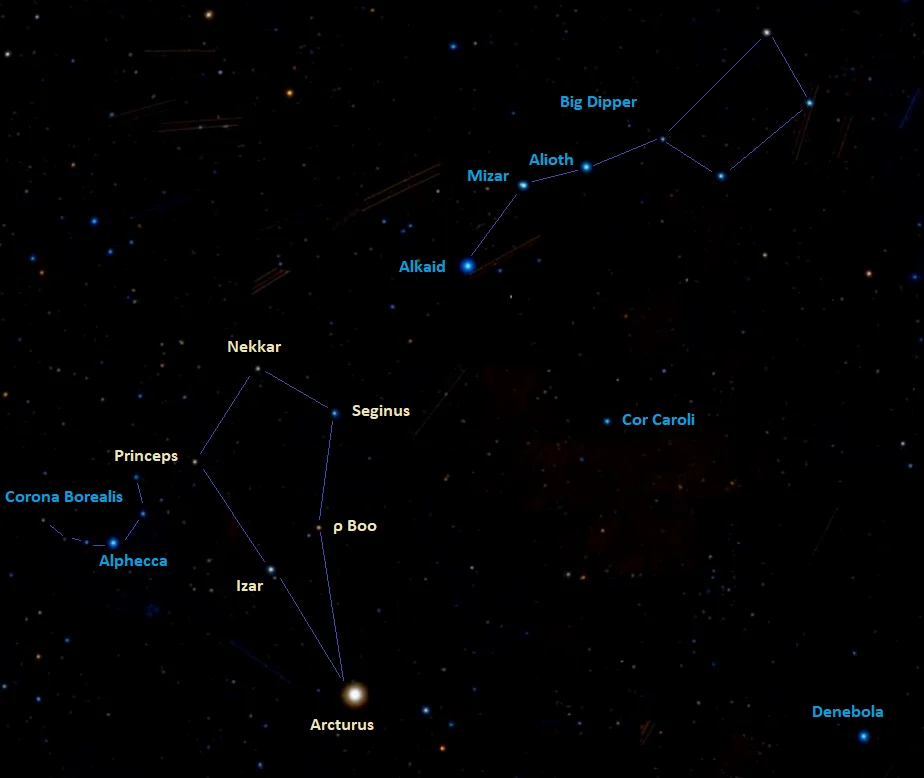
Location of the Kite, image: Wikisky
The entire Boötes constellation is visible from locations between the latitudes 90° N and 50° S. The Kite can be seen at some point in the night for most of the year from the northern hemisphere. It reaches its highest point in the evening sky (at 9 pm) in June.
Deep sky objects
The stars of the Kite can be used to find a number of notable deep sky objects in Boötes. Arcturus lies in the vicinity of the spiral galaxy IC 983 and its smaller neighbour IC 982. The two galaxies are catalogued as Arp 117 in Halton Arp’s Atlas of Peculiar Galaxies. They appear just southwest of Arcturus.
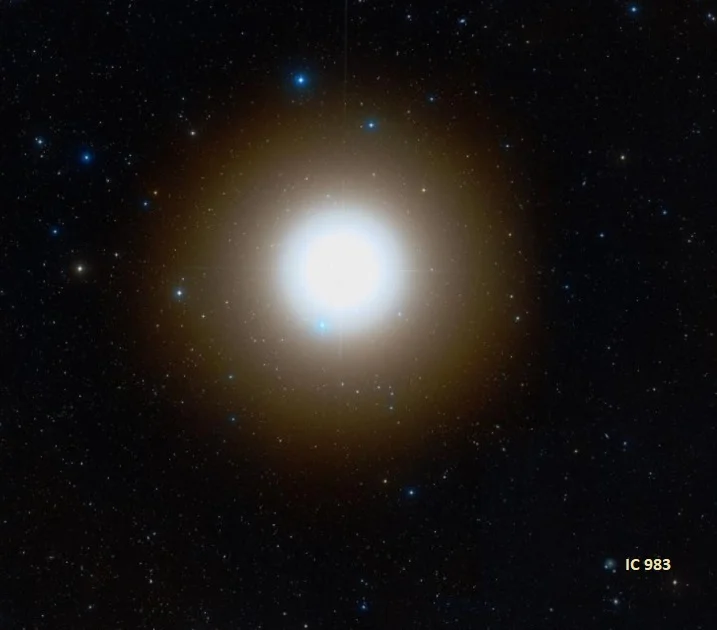
Arcturus and IC 983, image: Wikisky
The larger IC 983 is a barred spiral galaxy with loosely bound spiral arms. It occupies an area of 3.09 by 2.69 arcminutes of the apparent sky. IC 982 is a spiral galaxy with a LINER-type active nucleus. It has an apparent size of 0.590 by 0.555 arcminutes.
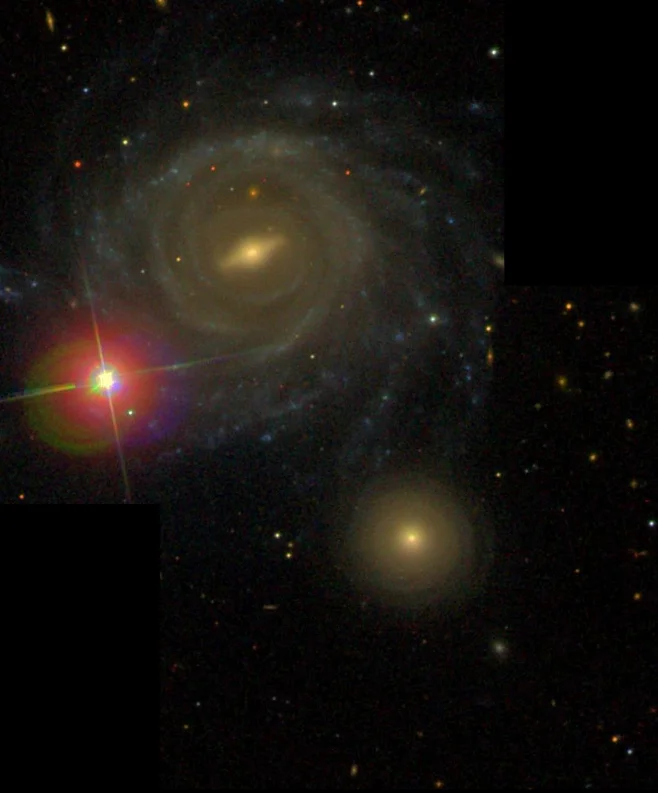
IC 982 and IC 983, image: Sloan Digital Sky Survey
Nekkar is the nearest bright star to the Seyfert galaxy NGC 5772, which appears west of the star. NGC 5772 is an unbarred spiral galaxy with an active nucleus. It has an angular size of 1.127 by 0.653 arcminutes.
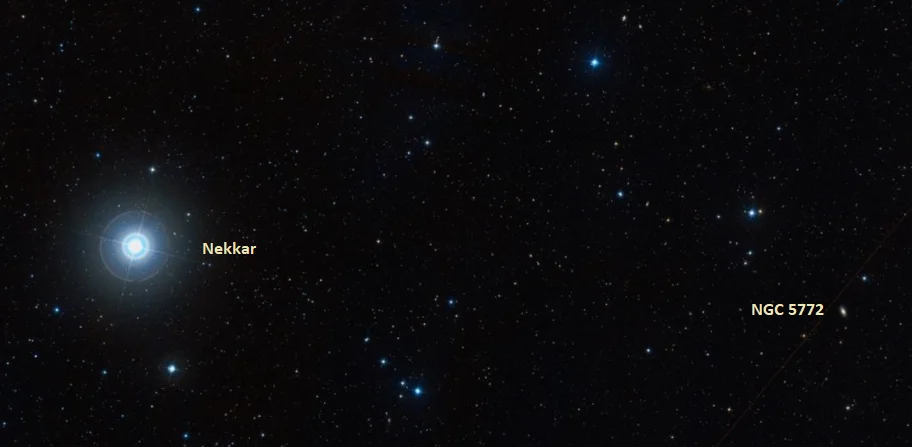
Nekkar and NGC 5772, image: Wikisky
Seginus appears near NGC 5698, a spiral radio galaxy with an apparent size of 1.127 by 0.631 arcminutes. The galaxy hosted a Type Ia supernova, SN 2005bc, in 2005. The supernova peaked at magnitude 15.3 soon after discovery.
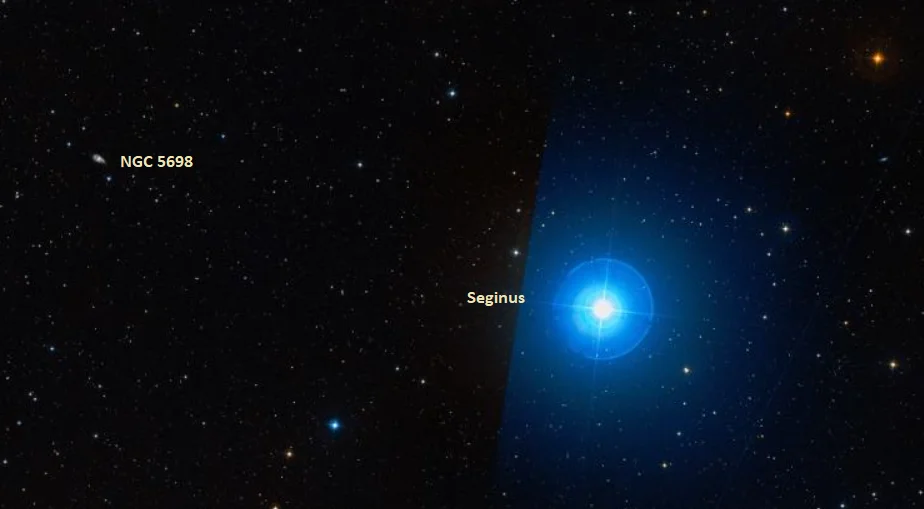
Seginus and NGC 5698, image: Wikisky
Rho Boötis lies in an area with several galaxies. The spiral galaxy NGC 5653 and the lenticular IC 4447 appear northwest of the star. NGC 5653 has an apparent magnitude of 12.9 and is located about 161 million light years away. It has an angular size of 1.7 by 1.3 arcminutes. IC 4447, a lenticular galaxy with an apparent magnitude of 13.7, appears smaller, with an apparent size of 1.20 by 0.8 arcminutes.
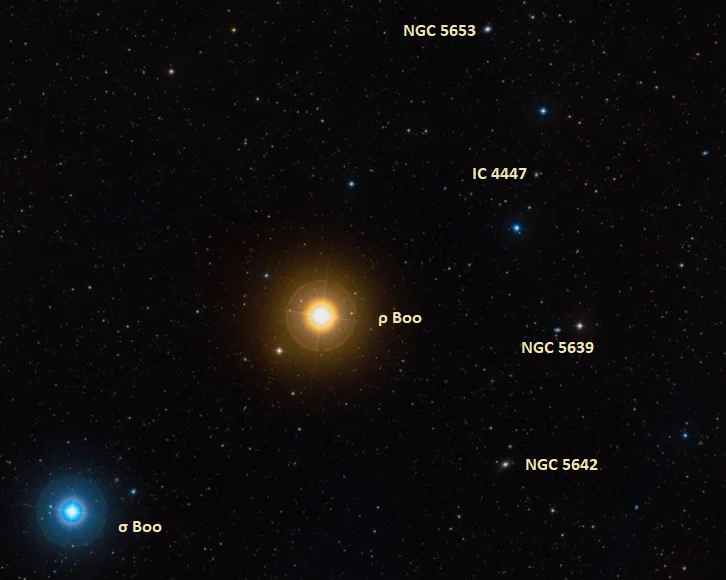
Rho Boötis, NGC 5653, IC 4447, NGC 5639 and NGC 5642, image: Wikisky
Located west of Rho Boötis, the spiral galaxy NGC 5639 has an apparent magnitude of 10.806 and an angular size of 1.259 by 0.813 arcminutes. The elliptical NGC 5642 is fainter (mag. 12.9) but larger (1.8′ x 1.3′). It appears southwest of the star.